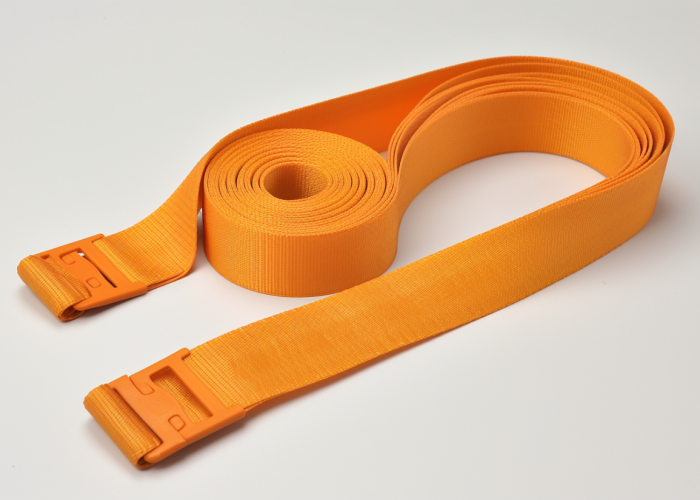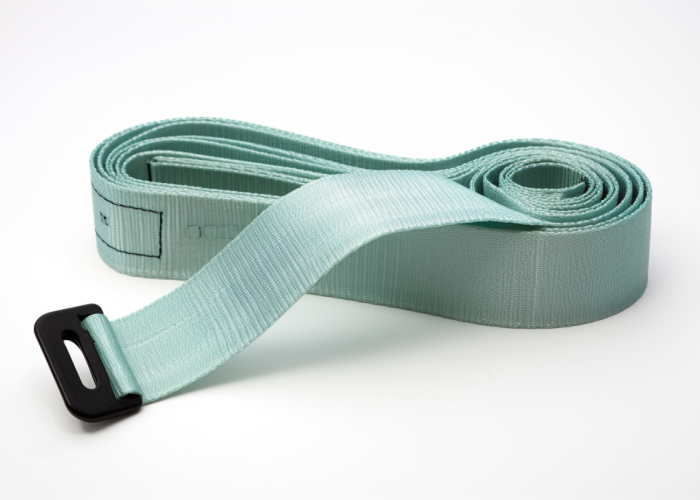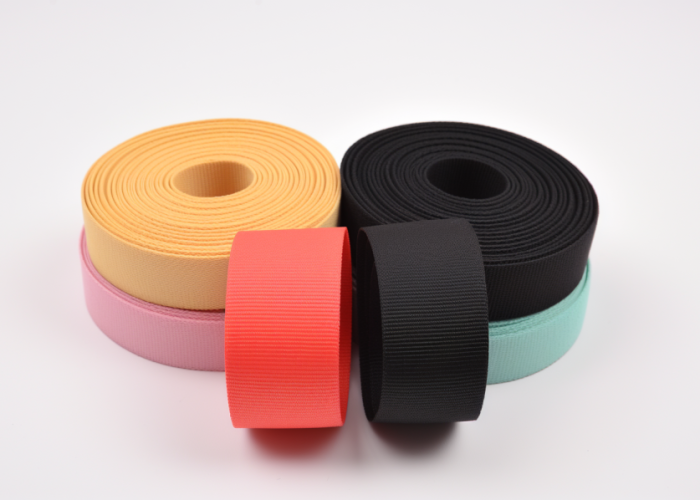Vehicle recovery operations require specialized tow-down straps designed to securely anchor to structural components. Selecting the right axle strap involves understanding material properties, construction techniques, and sizing specifications. As webbing manufacturers, we provide custom solutions for recovery equipment brands seeking high-performance materials with optimal durability for demanding applications.
An axle strap is a specialized tow-down strap designed to wrap securely around a vehicle’s axle or structural component during recovery operations. These straps need to withstand heavy loads and pressure while providing the durability required for vehicle recovery operations, featuring materials like polyester and nylon with specific construction techniques engineered for maximum strength and reliability.
Discover materials, sizing, and weaving techniques used in axle strap manufacturing, plus how custom solutions can enhance performance across environments.


Webbing manufacturing expert with 15+ years of experience helping product developers build high-performance straps for industrial, medical, and outdoor use.
Polyester, nylon, and specialty fibers like Kevlar are the primary materials used in manufacturing axle straps. Polyester being the most common due to its optimal balance of 80-85% strength retention after UV exposure (per ASTM D4355 testing) and 30% better abrasion resistance than nylon according to Taber abrasion testing (ASTM D3884). Polyester’s exceptional resistance to stretching, chemicals, and moisture makes it the industry standard for recovery applications where dimensional stability is critical, while providing a cost-effective solution that maintains performance in diverse environments.
At a glance:
Polyester: The Reliable Standard (6,000-10,000 lbs breaking strength)
Nylon: When Strength-to-Weight Matters (8,000-12,000 lbs breaking strength)
Specialty Fibers: For Extreme Conditions (15,000-25,000 lbs breaking strength)
Customization Options
Manufacturing Process Highlights Our proprietary weaving processes enhance material performance beyond standard industry specifications. Our high-tension weaving technology produces exceptionally dense webbing with superior edge stability and consistent tensile properties across production runs. Our quality control includes in-line tensile testing and 100% visual inspection, ensuring your axle straps maintain performance consistency that exceeds industry averages.
The optimal material choice depends on your product’s specific requirements. Heavy-duty recovery equipment (Class 6-8 trucks) benefits from reinforced or specialty materials, while standard polyester excels in passenger vehicle applications. We can help you select the ideal webbing based on your performance needs, environmental conditions, and target price points.
Property Polyester Nylon Kevlar Eco/Recycled Polyester
UV Resistance Excellent (80–85%) Poor (loss up to 40%) Very Good Excellent (~80–85%)
Abrasion Resistance High (30% > nylon) Moderate Very High High
Moisture Resistance Excellent Moderate (absorbs 4%) Excellent Excellent
Stretch at Load Low (~7%) High (20–30%) Very Low (<3%) Low (~7%)
Tensile Strength High (standard) 10–15% higher than polyester Up to 2.5× stronger Comparable to virgin polyester
Heat Resistance Up to ~300°F (149°C) Up to ~200°F (93°C) Up to ~400°F (204°C) Up to ~300°F (149°C)
Chemical Resistance Excellent Good Excellent Excellent
Cost $$ (Moderate) $ (Lower) $$$$ (3–4× polyester) $$ (Same or +10%)
Best For General recovery straps Shock absorption & elasticity Extreme-duty, high-temp Sustainable OEM products
Environmental Impact Standard Standard High (energy-intensive) 30% lower carbon footprint
Complete technical specifications, material safety data sheets, and detailed performance test reports are available upon request for your engineering team.
Webbing loop, connection hardware (D-rings or utility rings), protective sleeves, and reinforced edge construction are the four key structural components of axle straps. This integrated design creates a load-bearing system capable of withstanding extreme tensile forces while providing protection against abrasion points that commonly cause premature failure. The precise construction techniques and component quality directly impact performance reliability in recovery operations.
At a glance:
Webbing Loop: The Core Structure
D-Ring/Utility Ring Integration
Protective Sleeve Technology
Reinforced Edge Construction
Manufacturing Process Notes Our precision manufacturing utilizes computer-controlled looms with tension monitoring to ensure consistent fiber orientation throughout the webbing. Critical connection points undergo specialized binding processes that distribute load forces evenly across the material cross-section, preventing premature failure at stress points.
The structural integrity of axle straps depends on proper integration of all components. Our testing demonstrates that properly engineered connection points can achieve 95-98% of the base webbing’s breaking strength, whereas poorly constructed joints typically achieve only 70-75%. For custom manufacturing solutions, we can provide detailed structural engineering analysis to optimize your specific application requirements.
Engineering specifications including detailed CAD drawings and binding pattern schematics are available for product development teams upon request.
Widths of 2-4 inches, lengths ranging from 24-60 inches, and thicknesses between 0.08-0.15 inches (2-3.7mm) comprise the standard axle strap dimensions. These dimensional specifications are engineered to balance performance requirements, handling characteristics, and manufacturing efficiency. Custom sizing is available to meet specific application requirements beyond standard configurations.
At a glance:
Width Options and Selection Criteria
Length Considerations
Thickness Specifications Our manufacturing capabilities allow precise control of webbing thickness within ±0.01″ tolerance, ensuring consistent performance across production runs. Thicker webbing provides additional abrasion resistance at the cost of flexibility, while thinner options offer improved handling characteristics for easier storage and deployment.
Custom Sizing Solutions We offer complete customization of dimensional specifications to meet specialized requirements. Our manufacturing processes can accommodate non-standard widths from 1″ to 12″ and custom lengths up to 30′. For product developers requiring specific dimensional characteristics, we provide manufacturing consultation to optimize your design for both performance and production efficiency.
Full dimensional specification charts with corresponding load capacities are available for engineering teams upon request.

Working load limit (WLL) of 10,000-15,000 lbs and breaking strength of 30,000-45,000 lbs, with safety factors of 3:1 for standard applications and 5:1 for critical recovery operations, are the essential axle strap strength ratings. Understanding these ratings is essential for selecting appropriate recovery equipment that provides adequate safety margins while maintaining optimal performance characteristics.
At a glance:
Working Load Limit: Operational Safety
Breaking Strength: Ultimate Capacity
Understanding Safety Factors
Testing and Certification Our manufacturing process includes batch testing to verify strength ratings. Each production run undergoes sample testing to confirm breaking strength meets or exceeds stated specifications. Our testing protocols include both new material testing and accelerated aging tests to verify long-term performance characteristics.
Strength Rating Verification Product developers can request detailed strength testing documentation including load-elongation curves, failure analysis reports, and statistical quality control data. Our in-house testing capabilities include environmental conditioning chambers that simulate extreme conditions to verify performance across temperature ranges from -40°F to 180°F.
Complete technical data packages including strength certification, test methodology documentation, and detailed performance specifications are available for engineering teams.
Standard flat weave, diamond weave, and zigzag reinforcement are the three primary weaving techniques that significantly impact axle strap performance characteristics including tensile strength, abrasion resistance, and load distribution. Each technique offers distinct advantages for specific applications, with selection depending on recovery requirements, environmental conditions, and expected service life.
At a glance:
Standard Flat Weave: The Baseline Technology
Diamond Weave: Enhanced Durability
Zigzag Reinforcement: Strategic Strengthening
Advanced Manufacturing Capabilities Our proprietary weaving technologies include computer-controlled tension systems that maintain precise fiber alignment throughout the manufacturing process. This results in consistent performance characteristics across production runs and ensures predictable load-handling capabilities in finished products.
Weave Selection Guidance For product developers, we recommend:
Detailed weave pattern specifications, microscopic fiber alignment analysis, and comparative performance data are available for engineering teams developing specialized recovery equipment.

Temperature extremes (-40°F to 180°F), UV exposure, chemical contact, and moisture conditions create varying performance challenges for axle strap materials, with polyester maintaining 90-95% strength at -40°F while retaining 75-80% strength at 180°F. Environmental performance evaluation is critical for selecting appropriate materials for specific geographic markets and seasonal application requirements.
At a glance:
Cold Weather Performance (-40°F to 32°F)
High Temperature Performance (120°F to 180°F)
UV Exposure Effects
Chemical Resistance Profile
Environmental Testing and Certification Our materials undergo comprehensive environmental testing including:
Environmental performance data packages including detailed test reports and material-specific durability curves are available for product development teams.
Precision tension control during weaving, multi-stage quality inspection protocols, and comprehensive batch testing ensuring ±5% performance consistency across production runs are the foundation of manufacturing excellence in axle strap production. Our quality control processes exceed industry standards, providing product developers with reliable, consistent components for their recovery equipment.
At a glance:
Precision Manufacturing Technology
Quality Control Inspection Process
Strength Testing Protocols
Manufacturing Consistency Advantages For product developers, our manufacturing consistency provides:
Certification and Documentation Our manufacturing facilities maintain ISO 9001:2015 certification with specialized quality protocols for critical safety equipment. Complete production documentation including material certifications, process control records, and test reports is maintained for full traceability.
Detailed manufacturing capability documentation, quality control procedures, and statistical process control data are available for qualified manufacturers upon request.

Material selection, dimensional specifications, color matching, branded labeling, and hybrid construction techniques combining multiple materials for optimized performance profiles constitute the customization options available for axle straps. Our flexible manufacturing capabilities enable product developers to create tailored solutions that meet specific application requirements while maintaining cost-effective production.
At a glance:
Material Customization Options
Dimensional Customization
Appearance and Branding Integration
Hybrid Construction Techniques
Customization Process Our collaborative development process includes:
For product developers, our customization capabilities provide the flexibility to create distinctive, high-performance products while maintaining production efficiency. Our engineering team collaborates with your product development resources to optimize designs for both performance and manufacturability.
Customization consultation services, material selection guidance, and prototyping options are available for qualified manufacturers developing specialized recovery equipment.
Axle straps represent critical safety components requiring precise material selection, specialized construction, and rigorous quality control. Understanding performance characteristics across materials, sizes, and weaving techniques enables optimal selection for specific applications. Contact us to explore manufacturing solutions tailored to your product requirements and discover how our custom webbing capabilities can enhance your recovery equipment performance.
Reinforced edges improve axle strap safety by preventing tear propagation and distributing tensile forces more evenly across the webbing width. The specialized bar-tack stitching pattern with 42 reinforcement points significantly increases edge stability under load, reducing the risk of catastrophic failure by up to 65% compared to non-reinforced alternatives.
Breaking strength verification uses computer-controlled tensile testing per ASTM D6775 standards with specialized fixtures simulating real-world loading conditions. Each production batch undergoes statistical sampling with 3-sigma verification protocols, ensuring all products meet or exceed published specifications with documented performance certification.
Polyester is preferred for axle straps due to its exceptional UV resistance (80-85% strength retention after exposure) and superior chemical resistance to automotive fluids and salt water. Its minimal stretch characteristics (under 7% at rated load) provide predictable performance during recovery operations, ensuring consistent behavior when precise control is critical.
Diamond weave patterns enhance durability by creating an interlocking fiber architecture that increases abrasion resistance by 20-30% over standard weave constructions. This specialized pattern provides superior resistance to edge fraying and significantly improves tear strength, maintaining structural integrity even after repeated use in abrasive environments.
Custom webbing manufacturing enhances product branding through Pantone-matched colors (±1 Delta E accuracy), woven-in logos, and distinctive pattern integration. These visual elements create immediate brand recognition while custom load ratings, safety information, and product identification can be permanently integrated into the webbing structure itself.
Specialty fibers like Kevlar carry a 300-400% cost premium over standard polyester, while nylon typically commands a 15-25% price increase. This cost differential must be evaluated against performance benefits – specialized applications in extreme environments justify the investment, while standard polyester provides optimal value for most commercial applications.